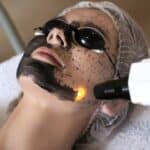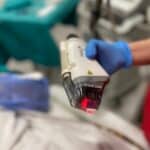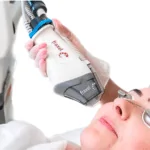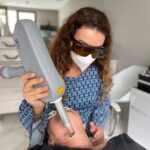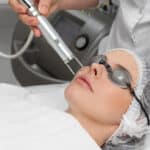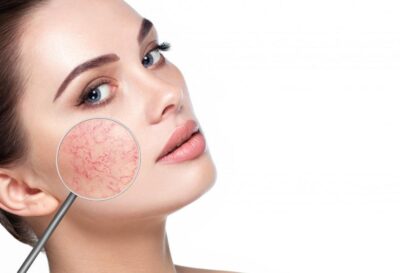 Laser capillary reduction treatment is generally based on the destruction of veins and broken capillaries by giving laser energy. Hemoglobin is a protein found in red blood cells. This protein absorbs laser beams, releasing energy that destroys blood vessels.
Laser capillary reduction treatment is generally based on the destruction of veins and broken capillaries by giving laser energy. Hemoglobin is a protein found in red blood cells. This protein absorbs laser beams, releasing energy that destroys blood vessels.
What is a broken capillary? Why does it occur?
The thin veins that increase in diameter enlarge, broken and appear as a thin line near the surface. These broken thin vessels are called broken capillaries. It is very common among the people. It is more common on the face and legs, but can occur in any part of the body. They occur mostly in people with fair skin color. These veins, which cause the skin to have a sensitive structure, can cause red spots and redness on the face. Capillaries, especially seen on the face, can disrupt the psychology of the person and affect them negatively.
Sensitive skin structure, exposure to excessive sun rays, rosacea disease, metabolic and rheumatic diseases, excessive estrogen, alcohol use, chronic cortisone use, previous traumas and genetic diseases may cause broken capillary formation in the face area. It has been observed that capillaries form in the nose after nose surgeries. The inability of the veins to carry the blood in the body to the heart effectively enough, the pooling of blood in the legs due to the effect of gravity, and the thickening of these veins over time also cause an increase in capillaries in the legs. Broken capillary formation is more common in women than in men. Increased temperature, excessive standing, prolonged sitting with drooping legs also trigger an increase in broken capillaries.
How is broken capillary reduction with laser applied?
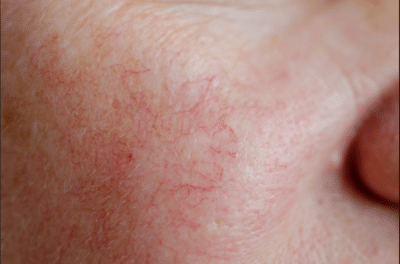 There are broken capillaries formed for many different reasons. Factors such as hereditary features, pregnancy, aging of the skin, exposure to excessive sunlight, sudden weight gain, tight clothes and tight socks preferred, and less fluid consumption trigger the formation of capillaries. However, the actual reason for the formation of capillaries is not yet known. However, it is a more common skin problem in women than in men.
There are broken capillaries formed for many different reasons. Factors such as hereditary features, pregnancy, aging of the skin, exposure to excessive sunlight, sudden weight gain, tight clothes and tight socks preferred, and less fluid consumption trigger the formation of capillaries. However, the actual reason for the formation of capillaries is not yet known. However, it is a more common skin problem in women than in men.
If a possible risk factor for health is not observed in the patient, broken capillary treatment is started. In this treatment method, laser is mostly applied, and sclerotherapy and radiofrequency methods can be applied in deep and large veins. The most appropriate treatment method to be determined by the dermatologist is preferred according to the patient and broken capillary type. In the laser treatment method, it heals easily compared to other treatment methods, the pain is less, the procedure takes a short time and the patient continues his daily life immediately. In addition to laser, in all other treatment methods, the level of pain felt during the application is minimized with the help of cooling technique and pain relief creams.
How is broken capillary reduction done with laser?
In the past, the method used to eliminate the broken capillary problem was usually electrical burning of possible complications. With this method, only small broken capillaries were destroyed. Later, with the use of devices that apply beam and light energy, nd YAG lasers, IPL and BBL treatments have made progress in the treatment of this disease.
Nd YAG lasers provide visible and significant success even in a single session in unwanted vascular enlargement on the sides of the nose and face and in superficial broken capillary networks in the legs, which are generally seen in women.
With the energy of the laser beams given, it concentrates on the veins in the area where the application will be made. Afterwards, this energy is transferred from the laser to the vein and absorbed by the veins, thus preventing the blood from clogging. The vessel that no longer carries blood is absorbed by the body and the appearance of broken capillaries disappears. The process of burning these vessels does not pose any problem in terms of blood circulation, because the skin tissue here is fed from many different places.
Laser capillary treatment is generally based on the destruction of veins and broken capillaries by giving laser energy, as mentioned above. Hemoglobin is a protein found in red blood cells. This protein absorbs laser beams, releasing energy that destroys blood vessels.
How does laser capillary treatment work?
During capillary treatment, laser light is absorbed by the hemoglobin in the vessel. Reaching a certain level of heat in the vessel, it coagulates the vessel and renders it dysfunctional. Thus, it is digested by relevant cellular mechanisms.
How many sessions does laser capillary treatment take?
The duration of capillary treatment varies according to the thickness, depth, width and location of the vessel. Generally, the treated area fades in a single session, but if the vascular network is too wide and many, the treatment may need to be divided into more than one session. Between two sessions, it takes an average of 4-6 weeks. After the 2nd or 3rd session, the effectiveness of the treatment begins to increase.
Who can be applied laser capillary reduction?
Determining the appropriate candidate for capillary therapy should be carried out by a specialist doctor. But in general, this treatment can be applied to anyone of any age.
What are the side effects of laser capillary treatment? Is it a harmful operation?
Laser capillary treatment is not a harmful procedure and has very few side effects.
In order to prevent possible complications, the application area should be avoided from the sun. In general, most people experience redness in the treatment area after the procedure, but these rashes heal quickly and are temporary.
Although rare, swelling or tingling in the treated area may occur after treatment. If such a complication is seen, it would be beneficial to see a doctor. Where there are small capillaries removed during the procedure, bruising may occur later, but this is also temporary.
The most common side effect of the laser capillary treatment is the redness of the application area. Although not much, a slight redness may occur. In addition to redness, blistering and crusting are also common.
What should be considered for laser capillary treatment?
Exposure to excessive sunlight also causes the veins to dilate. It is very important to protect the skin after capillary treatment. The most important thing to do after the treatment is to avoid the sun as much as possible. If there is an underlying disease that will cause an increase in broken capillaries (such as rosacea, or circulatory failure in the legs), these conditions should also be treated. It is recommended to use sunscreen lotions and creams continuously.
Is capillary treatment a painful procedure?
Capillary treatment is not a painful application. Most laser treatments only cause mild pain and this is temporary. Although the heat emitted by the laser gives a burning sensation to the body, this is normal. During this treatment, the patient may be given anesthesia. This prevents you from feeling pain during the procedure. In addition, pain can be alleviated with various cooling systems and local anesthetic creams.
Why do facial broken capillaries occur?
- Thin and sensitive skin
- Suffering from rosacea
- Prolonged exposure to direct sunlight
- Using cortisone cream for a long time
- Having lupus and similar diseases
- Radiation treatments
- Using birth control pills and other hormonal treatments
- Age and other genetic factors
- Some hematologic diseases
- Nose surgeries are among the causes of capillary cracking on the face.
How is facial capillary reduction done?
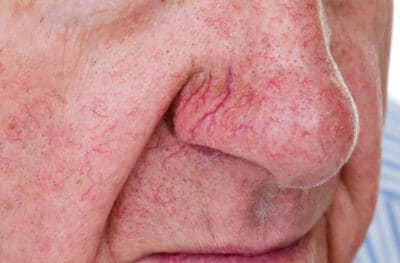 Today, capillary treatment is carried out effectively with successful laser and light treatments. Technologies such as nd YAG laser, 4D laser, IPL application and KTP laser can be counted among the widely used laser technologies. During the procedure, the laser beam method is used along the broken capillary.
Today, capillary treatment is carried out effectively with successful laser and light treatments. Technologies such as nd YAG laser, 4D laser, IPL application and KTP laser can be counted among the widely used laser technologies. During the procedure, the laser beam method is used along the broken capillary.
Capillary treatment with laser is applied in the treatment of fine capillary cracks. The aim of laser beams is oxyhemoglobin in the blood. Laser beams are sent to the broken capillaries. The veins are damaged by overheating and thus slowly disappear. A faster recovery is observed in thick veins than in thin veins. The width of the large vessels is important because they carry more blood oxyhemoglobin. This method can also be applied for facial redness diseases such as rosacea and flushing.
Is capillary treatment permanent?
Laser capillary treatment is an extremely effective treatment. The applied procedure is a treatment-oriented procedure. For this reason, the recurrence of capillary vessel formation in the application area is low. However, there may be new ones, albeit rare. Broken capillary problems, especially on the face, may recur. But usually the treated capillaries do not recur. There may be new ones. It is important to use sunscreen creams after the treatment.
What are the rules to be followed after laser capillary reduction?
After capillary treatment, side effects such as a mild burning on the skin, a slight redness and crusting may occur.
– Especially in the first few weeks after the treatment, the area where the procedure is performed should not be exposed to sunlight and should not go to the solarium. If it is not possible to avoid exposure to sunlight, it would be beneficial to use high factor sunscreen creams before going out.
– It is also important that the water is not too hot during the shower. It is necessary to wash the body in the warmest water possible.
How much is laser capillary reduction? Capillary treatment prices
The duration of laser capillary treatment varies according to the cause and severity of broken capillary formation. The most effective method of capillary treatment is laser reconstruction. It must be applied by specialist doctors. It is possible to get rid of the bad appearance with capillary treatment. Capillary treatment prices vary depending on many different factors such as the skin structure of the person. It is not legal for centers approved by the Ministry of Health to specify prices on their websites.
You can reach our clinic by calling +90212 241 46 24 to learn the most suitable treatment method for you and for all your other questions.

